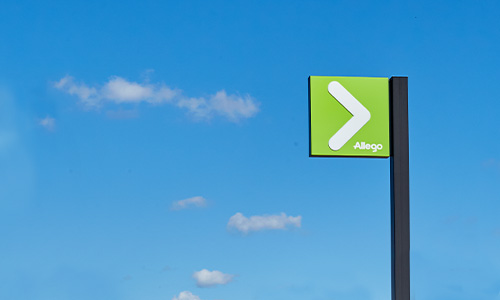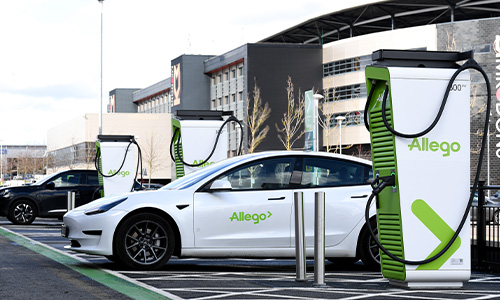
We'd love to answer all your questions
Please visit our Pricing Page or use the Smoov-app to check the exact rates of the charger you are using. If you charge via a charge card of a Mobility Service Provider (MSP) the final rate can differ from Allego’s default rate. Please contact your MSP for the current rates.
You can easily find a charging station using our map which shows all available chargers in your area. On this map, you can filter on charge points that are suitable for your type of electric car. Or use the Smoov app for available chargers in your area.
If a malfunction should unexpectedly occur, please call the hotline number shown on the charging station. Our experts will help you immediately. Please make sure you have the reference number of the charging station to hand. You can find the local hotline number on our Live Support page.
Regular (AC) charging sessions can be paid for by using an MSP charging card. Or with all major creditcards or SEPA direct debit using our Smoov App.
Fast and ultrafast (DC) charging sessions can be paid for by using an MSP charging card or our Smoov app. Most of our DC chargers also accept contactless payments by creditcard, debitcard, Apple Pay or Google Pay.
As a Charge Point Operator we do not provide charging cards ourselves. You can request a charging card at one of the MSPs in your region.
You can search for the top MSPs on the following websites.
The Netherlands: https://laadpastop10.nl/
Germany: https://www.goingelectric.de/stromtankstellen/anbieter/
Belgium: https://ik-rij-elektrisch.be/laadpassen/
United Kingdom: https://www.zap-map.com/charge-points/ev-energy-tariffs/
There could be multiple reasons for this.
- You have a new MSP card that is not yet activated. In this case, you need to contact your MSP to activate the card.
- Your MSP does not have a contract with Allego. Even though we accept cards from most MSPs this can be the case. Contact your MSP to check if your card is valid on the Allego network.
- The new card is not yet registered at Allego. In this case, your MSP needs to send us the card information.
- Please contact us if the above is not the case and we are happy to help.
Regular AC Charging
You need a Type 2 charging cable that is suitable for regular charging. You have to bring your own cable that belongs to your vehicle.
Fast DC Charging
Almost all full electric vehicles (battery electric vehicles) can charge at our DC chargers using a CCS or a CHAdeMO plug.
Please visit the Smoov website to read more about the app and install it on your smartphone. You can use the Smoov app to find all the chargers in your area. You can also use it to start and pay for charging sessions at our chargers.
We have created an overview of our ultrafast charging locations. Here you will find pictures and more details about the locations such as facilities, route description and availability of chargers.
The price you pay to charge an EV may differ between charge points. This depends on the type of charge point (fast charger or regular charger) and its location (price set in a tendering process or open market model). For the current rate per Allego charge point, please go to our Pricing page or download the SMOOV app.
The price you pay per kWh, time or other rate component is made up of several elements. They are the use of the grid operator’s network, the use of the charge point, the supply of energy, and taxes. If you pay for the charging session using an App or an MSP charging card, the final price you pay depends on the contract you have with your charge card provider. Some MSPs charge Allego’s standard rate directly with a mark-up, others create their own rate or type of subscription.
Charging with more power requires a more robust electricity supply. This is much more expensive both to build and to operate in comparison to regular speed charging stations. It also requires a different type of charger with more functionality than a regular charger.
Preauthorization is essential for Allego to ensure the validation of drivers’ funds availability before initiating the charging session. This process helps prevent potential issues or interruptions during the session due to insufficient funds, ensuring a smooth and reliable charging experience for users. Without it, there may be uncertainties regarding a driver’s ability to cover the cost, potentially disrupting the charging process.
Allego consistently monitor the charging sessions and mirror the expected cost in the preauthorization amount. This alignment ensures that users have adequate funds to cover their charging expenses reliably.
In recent years, many local authorities have grouped together with the province(s) in order to offer larger volumes to market parties. This gives you economies of scale and a lower price for charging your EV. This trend has intensified over the past year, resulting in differences in individual contracts. This is why different rates are charged in the same village or town: charge points are installed under the ‘open market model’ or under a tendering process.
We also sell chargers and charging services to companies. These companies can decide for themselves what rate they charge guests for using their chargers.
The rate is set by the owner or operator of the charge point. If the charge point was installed under a tender, it is usually the party that granted the concession that sets the rate or rate conditions.
You pay the standard rate if you pay directly for your charging session at an Allego charge point, e.g. contactless on one of our (ultra) fast chargers or via the SMOOV app. This is also the rate charged on to MSPs.
Some MSPs charge Allego’s standard rate directly with a mark-up. Other MSPs create their own rate or type of subscription. We have no influence over what the MSP charges to its customers. Please contact your MSP for your applicable rate.
You can check what rate is charged at all Allego charging points. You can do this by selecting the charge point you want to know about in the map of our Find Us page, or by downloading the Smoov app and looking up the charge point.
If your MSP claims that it also charges this rate, we advise you to contact your MSP. Mention which specific charge point is involved so that your MSP can contact us.
If you start your charging session in the Smoov app or use an MSP card you have linked to Smoov, you can always monitor the progress of your charging session in Smoov. This informs you about the components that determine the final price of your charging session, such as charged kWh and time. You will also receive a message when charging is complete.
After finishing the charging session an overview of the charging session is displayed in Smoov and you can download a receipt. Did you pay directly to us? If so, you see the exact cost of the charging session at the standard charging rate. For the total amount of a charging session using your charging card, please contact your MSP. Your MSP will issue an invoice based on the rate agreements you have made with it.
If you have used a contactless payment method on one of our (ultra) fast chargers you can download the receipt here. Fill in the payment reference given with the Allego payment in the transaction overview of your bank account.
You can download your receipt here.
The charging time of an electric vehicle depends on several factors: the current charge of the battery and the total capacity of the battery, the charging technology in the electric vehicle, the equipment and type of charging station available and the type of charging cable used. For example a BMW i3 with 11 kW AC charger charges up to 11 kWh per hour at an AC charging station with a three-phase charging cable. A single-phase charging cable only charges 3.7 kWh per hour.
Oh no, that sounds like a frustrating situation! If your charging cable is stuck in a charging station, here’s what you can do:
Immediate Steps
- Try locking and unlocking your car a few times using your key, up to a maximum of seven times if necessary.
- Turn your car on and off.
- If that doesn’t work, briefly start a new charging session and stop it immediately.
- If none of these steps work, use the emergency release in the car while the cable is still connected.
Call the Allego Hotline
If the above steps don’t resolve the issue, it’s time to call the Allego hotline. Their experts are available 24/7 to assist you. Make sure to have the charging station’s ID number ready when you call. In most cases, the cable can still be disconnected with the help of our staff.
What if the Cable Won’t Release?
If the vehicle is connected to a DC/CCS or CHAdeMO fast charger, which are not detachable from the charger unit. Charger connectors are locked into a vehicle’s charging port by a mechanism within the vehicle’s charging port itself. This is a security measure.
To release the cable the car assistance needs to unlock the car from the cable.
If the vehicle is connected to a AC/Type 2 slow charger, and that the connector is no longer connected to the vehicle.
All countries; ticket will be sent on Prio High to Service partner. They will contact you for further actions and return of the cable.
Netherlands only:
If the cable still cannot be disconnected, Allego will arrange additional assistance. Here’s how that process works:
- ANWB Roadside Assistance
Our call center will contact the ANWB roadside assistance service to release the cable. It’s essential for you, as the EV driver, to be present at the charging station when the assistance arrives. This ensures the situation is handled quickly and correctly. - Updates and Waiting Time
Within 25 minutes of your report, you will receive an SMS with a track-and-trace link so you can monitor the progress. In most cases, the roadside assistance team will arrive at the charging point within 90 minutes of the report to unlock and hand over the cable.
Important Notes
- Liability: If your charging cable gets stuck in the charging station, Allego is not liable for any damage to the charging cable.
- Shipping Costs: We do not offer this, only in very exceptional cases. If the cable needs to be sent or bring back to you, the associated costs will be at the EV driver’s expense. Therefore, make sure you are at the location at the time help arrives.
If a non-electric car is parked at the parking lot which is reserved for an electric car, you should contact the responsible municipality to report the matter.
If you are at the charging station, the best thing to do is call our hotline. Our experts can usually help you straight away. Make sure to note down the charging station number before you call. Click here for the local hotline number. You can also find it at the charger.
Plug and Charge
Plug and Charge is a new technology that allows electric vehicle (EV) drivers to automatically authenticate and authorize charging sessions simply by plugging in their vehicle. It eliminates the need for RFID cards, mobile apps, or any other manual authentication methods.
Plug and Charge leverages secure communication protocols between the EV and the charging station. When an EV is plugged into a Plug and Charge-compatible charger, the vehicle’s identity is authenticated using a digital certificate, and the charging session is automatically authorized.
We will launch P&C in the Netherlands and Germany in early Q4 2024, with other regions to follow.
Plug and Charge requires both the EV and the charging station to be compatible. Most new EV models from major manufacturers support this technology. Please refer to your vehicle’s user manual or the manufacturer’s website for compatibility information.
Or use this link to see if Plug and Charge is supported:
To set up Plug and Charge, you need to register your vehicle with your EV service provider or directly with the CPO, depending on the network. This typically involves providing your vehicle’s identification details and associating a payment method.
Some EVs may require a software update to enable Plug and Charge functionality. Check with your vehicle manufacturer or dealer for information on software updates.
Plug and Charge won’t be automatically enabled for all vehicles. Your vehicle must support the Plug and Charge standard (ISO 15118), and you need an MSP contract that offers Plug and Charge services.
Contact your MSP (linked to your leasing company) to activate Plug and Charge. You’ll need to register your vehicle and payment details through the MSP’s portal or app.
Simply plug your compatible EV into a Plug and Charge-enabled charging station. The vehicle and charger will handle the authentication and authorization automatically, and the charging session will begin.
Plug and Charge-enabled charging stations are typically labeled with specific signage. Additionally, you can check the charging station’s details on your charging network’s mobile app or website.
When you plug in a vehicle with Plug and Charge enabled, it will automatically start a charging session using the default payment method. To switch to a credit card or another payment method, you’ll need to stop the Plug and Charge session and start a new one using your preferred payment option before plugging in the car again. This may vary depending on the charging network.
If Plug and Charge is set as the default in the vehicle, it will start automatically when you plug in. However, drivers can disable Plug and Charge in the settings or choose another payment method, like an RFID card or mobile app, depending on the station and vehicle interface.
To switch payment methods for Plug and Charge, you’ll need to update your payment method with your Mobility Service Provider (MSP), not the car manufacturer. Some vehicle systems allow payment management, but most updates happen through your MSP’s app or website.
Plug and Charge authentication is quick, typically taking just a few seconds.
Usually, it takes a few seconds to a minute for the charging process to start, depending on the charging station and the car’s communication.
Billing for Plug and Charge sessions is handled automatically. The payment method associated with your account will be charged based on the charging session’s details, such as the amount of energy used and the duration of the session.
Yes, you can view your charging session history and download receipts from your account on the charging network’s mobile app or website.
Yes, Plug and Charge will apply idle fees if they are part of your MSP’s billing structure. These fees are charged when the car remains connected after it’s fully charged.
Yes, Plug and Charge uses secure communication protocols and digital certificates to ensure the authentication process is secure. Your payment and personal information are protected throughout the process.
Your personal data is handled in compliance with privacy regulations and policies. Only the necessary information required to authenticate and authorize charging sessions is shared between your vehicle and the charging station.



